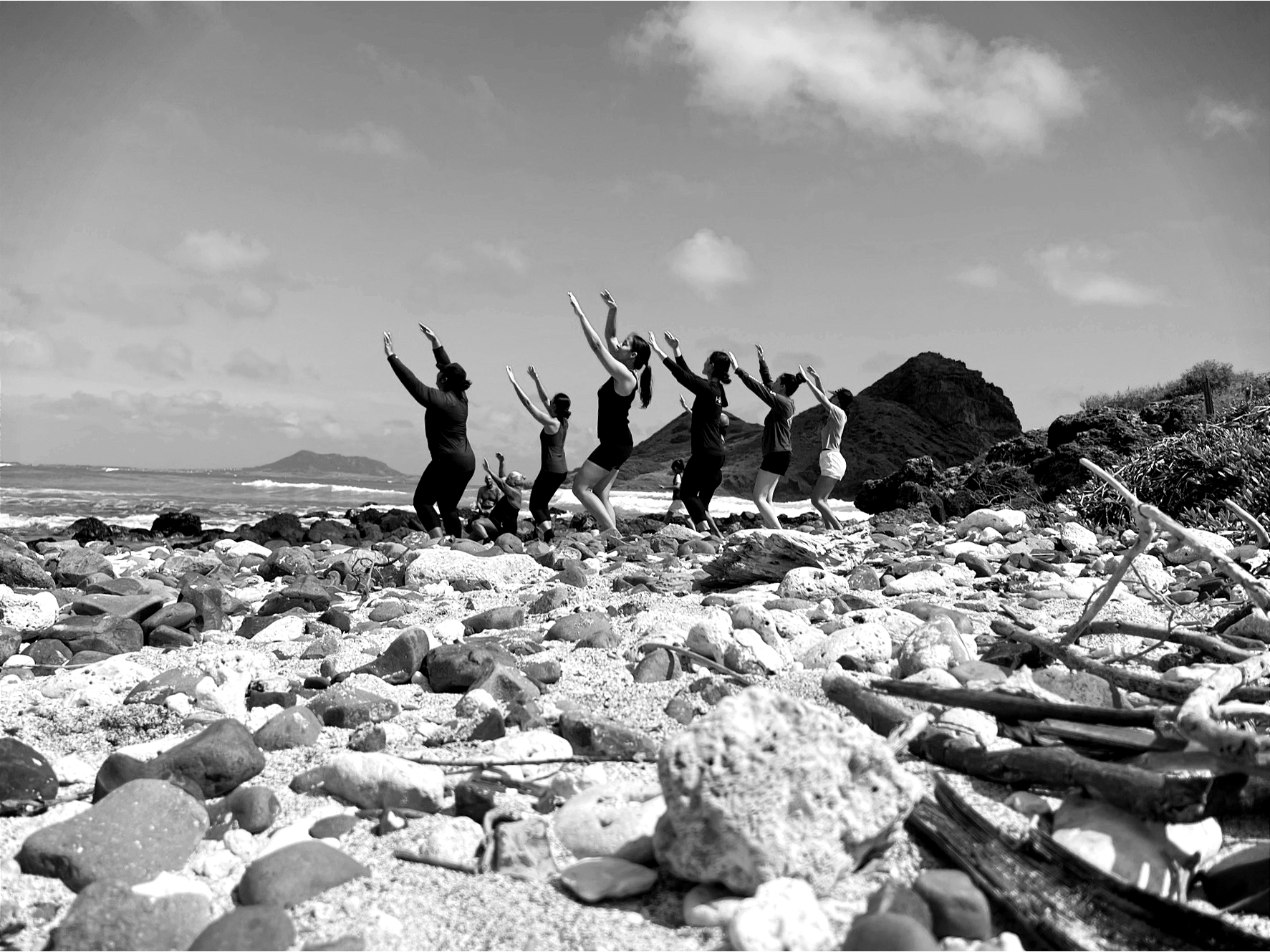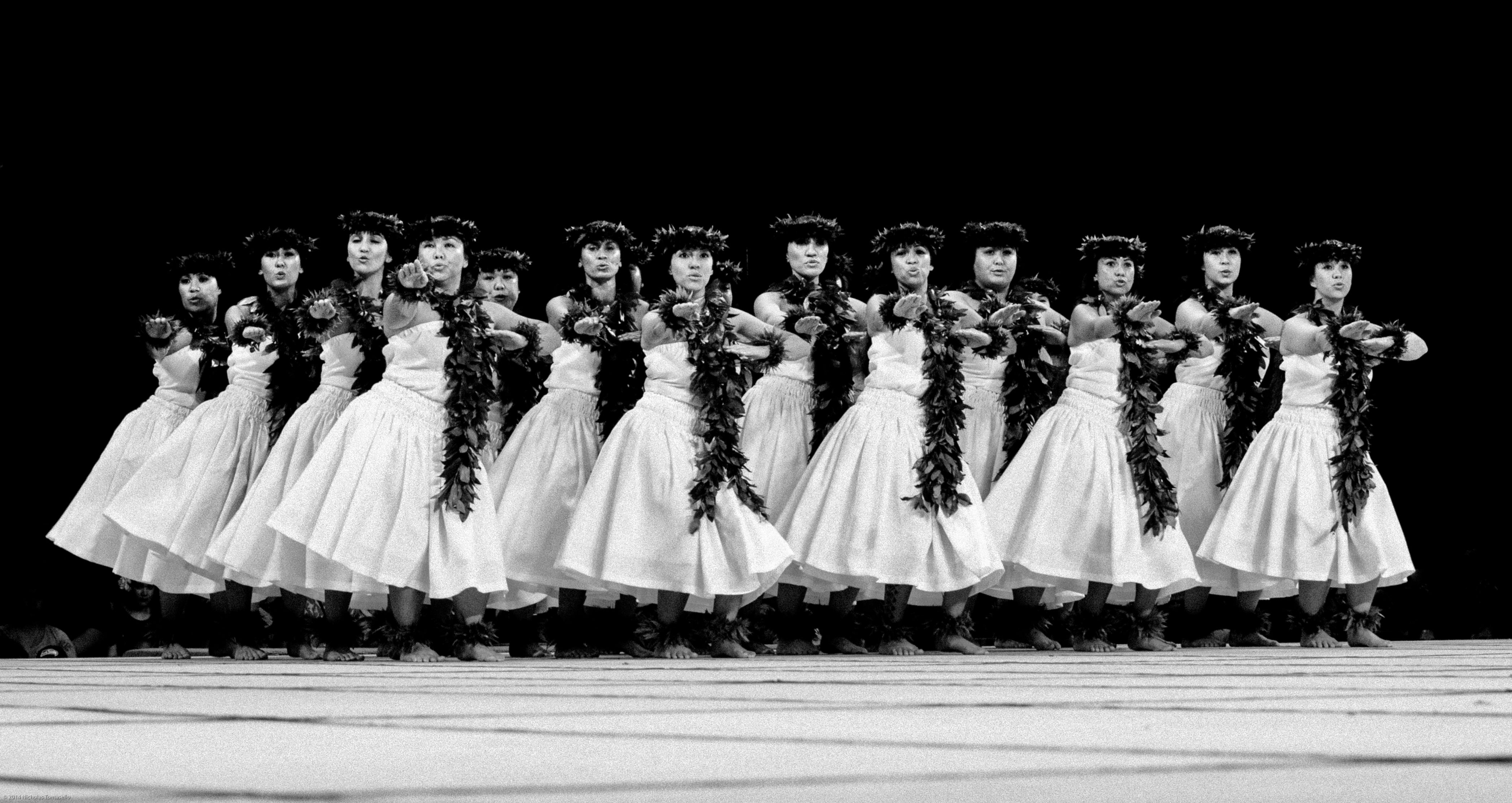
essays from our mm factsheet archives
E HOI KE ALOHA I Niihau
Hula Kahiko 2022
Tom Hiona makes the outlandish claim in his Ethnic Folkways recording of “Hoi Kealoha i Niihau” that the mele “tells the story of the high priest Paoa, who led his people to the island of Niihau in search of the sacred hidden waters and finally found the secret by following the flight of the kolea or red-breasted plover birds.” His liner-note explanation confuses the priest Paao with both the fish paoo and the Lehua Island place-name Waihunaakapaoo, a rocky spring inhabited by those fish, and he goes on to misidentify tuxedo-dressed kolea as red-breasted. I can only conclude that Hiona’s misinformation is so off-base as to be deliberate – an inside joke …
Mokulua
Hula Auana 2022
I composed the words of this mele in September 1988, after a visit with Aunty Sally Wood Naluai at her home in Kahaluu, Oahu, where Māpuana and Aunty Lani “Nana” Kalama (Sally’s hula sister with Maiki when they studied under Lokalia in the 1940s) spent the morning reviewing “Eia mai Au o Makalapua” at Aunty Sally’s feet.
Mapu learned “Makalapua” from Aunty Sally in 1985-86, after Aunty Nana explained to us that Sally had learned this hula kuolo from Mary Kawena Pukui and that, over the years, it had become one of the hula with which Sally was most closely associated. “I want you to learn it,” Aunty Nana had said, “from the person who probably knows it best.”
ka Lae o alala
Hula Auana 2022
To put it briefly: Kualoa, Mokukapu, and Mokumanu are there on the north. Popoia rests directly offshore. And Mokulua, Kaiolena, Kaiwa, and Wailea reach to the south. These are wahi pana on the Koolau shoreline that can be named, in sequence, from the vantage point of Ka Lae o Alala. When named, that is, by one who still knows and clings to these names, by one who is an ilima noho papa, an oiwi of Kailua whose family has made the decision, generation after generation, to name them, to know them, and – above all – to stay put. Kapalaiula de Silva’s mele is a net of inoa aina that helps to order our world and hold it in place. Alala, for reasons simple and profound, is the piko of this net.

KE AKUA UWALO
Hula Kahiko 2018
Mapuana learned “Ke Akua Uwalo i ka Lai” from Pat Namaka Bacon (Aunty Maka) in June 1986, as a hula kaʻi for “Poliahu,” the Pukui-composed hula pahu that Aunty Maka taught at that same ’86 Kalopa workshop. We know that “Ke Akua Uwalo” belongs to the tradition of Keahi Luahine who taught it to Kawena Pukui and Aunty Maka as the kaʻi for both “Kalani Manomano” and “Hamakua Au” – two of the three hula pahu in the Keahi Luahine tradition. We know, too, that “Ke Akua Uwalo” was used as the kaʻi by Pukui for her debut performance of “Poliahu” on December 19, 1985, and that it has become part of the “Poliahu” performance tradition as it continues to be practiced today by the kumu hula who were present at Kalopa: by Māpuana, Vicky Holt Takamine, and Kahai Topolinski.
poliAHU
Hula Kahiko 2018
Mapuana learned “Poliahu” from Aunty Pat Namaka Bacon on June 21, 1986, at Keahi Allen’s SCHH workshop at Kalopa, Hawaiʻi. Aunty Maka explained that her mother Mary Kawena Pukui composed it for Maka’s sister Pele Suganuma to dance in the mid-1950s, partly as a response to the inappropriate use of the ulili step by Lokalia Montgomery in “Ulei Pahu i ka Moku.” That hula pahu was one of three that Keahi Luahine had taught to Kawena and Maka (along with “Kalani Mano-mano” and “Hamakua Au”), and Keahi had then assigned the keeping of these three hula pahu specifically to the mother and daughter team. They subsequently taught “Ulei Pahu” to Lokalia who had difficulty learning its complicated foot pattern – the five hela (in five beats) and one kii (in three beats) . . .
mahaiula
Hula Auana 2019
“O kekahi mau mea e hoomanao ia e pono ai e poina ole ia e ka noonoo o ke kanaka e ola ana i keia la ame kela mau la aku la mai ka 1870 mai, no keia kowa o 53 makahiki a oi, oia no ka noho ana o na ohana ma keia mau apana o Kekaha mai na Honokohau, Kaloko, Kohana-iki, na Ooma, Kalaoa, Haleohiu, Makaula, Kau, Puukala-ohiki, Awalua, na Kaulana, Mahailua [sic.], Makala-wena, Awakee, na Kukio, Kaupulehu, Kiholo, Keawawaiki, Kapalaoa, Puuanahulu, ame Puuwaawaa.
He mau aina piha kanaka keia ia mau la, na kane, wahine a me na keiki piha na hale me na ohana nui a lau-kanaka maoli no. Holoholo pu au me na keiki kane a me na kaikamahine oia mau la a noho pu a hele pu no a ai pu no hoi me lakou a moe pu me ko lakou mau Home aloha.” [The writer now provides a list of … ]
MORE FROM OUR MISS ALOHA HULA FILES
MAKANANI AKIONA

HANOHANO O MAUI
Hula ʻAuana (Kaʻi / Hoʻi) 2011
Kahikina de Silva composed this mele in August 1995 for the 12-year-olds of Halau Mohala Ilima who – after a year of studying Maui hula at home on Oahu – had just returned from three days of ike maka experiences on Maui itself. The travel sequence of Kahikina’s song follows the itinerary of a work-shop that we have been conducting, now, for almost twenty years. On day one, we visit Iao Valley, discuss the legacies of Kakae and the battle of Kauaaupali, swim in the tingling waters of Kepaniwai, sing “Na Alii Puolani,” and dance “Maui o Kama,” and “Hanohano Waiehu.” On day two, we stop at what was once Pua Mana, think . . .
NANI WALE KEANAE
Hula Auana 2011
One of the most compelling images in Hawaiian poetry is that of the pohaku ku, the anchor stones used by fishermen and kapa-makers to keep their net-bottoms from furling in the tide and their set-out-to-dry bark cloth from flying away in the wind. Chants like “Aua Ia” and “Hulihia ke Au” warn us of the danger of neglecting these stones; if we allow them to come loose or roll free, then the fabric of our identity will be lost to the currents of time and change.
For all their apparent warmth and inclusivity, the best-known Maui compo-sitions of Alice Johnson are pohaku ku, carefully place anchor-stones that hold down her old timer’s ikena …
and that’s not the half of it*
He inoa no Henelika
Hula Kahiko 2024
Henelika is leaving Lahaina. The circumstances of her departure are indicated by the Paupili rain and the Kauaula wind: the one holds her in loving embrace; the other …
Mahalo Lahaina
Hula Auana 2024
Loko Snakenberg’a night school Hawaiian language class was a famous-aunty class, full of laughter, talk-story, and Hawaiian music. Its matriarchs were Irmgard Aluli …
Ulupo nui
Hula Auana 2023
This is a mele composed for the founders, guardians, and caretakers – past and present – of Ulupo Heiau in Kailua, Koolaupoko, Oahu. Ulupo Nui, greater Ulupō …
nane puniu
Hula Kahiko 2023
Samuel Kekoowai describes several disparate uses of gourd containers in his “Makalei Ka Laau Pii Ona a ka I-a.” a moʻolelo published serially in the nūpepa Kuokoa, 1922-24. In one episode, Pakui disregards the …
Aloha Waiauia
Hula Kahiko 2023
Loko Snakenbergs’s night school Hawaiian language class was a famous-aunty class, full of laughter, talk-story, and Hawaiian music. Its matriarchs were Irmgard Aluli and Leiana Woodside …
Ka ui o na pali koolau
Hula Auana 2023
This mele was composed in 1881 or earlier, by Sylvester Kalama, Aunty Vickie Ii Rodrigues’s grandfather. Much like his “Pua Mikinolia,” this is a let’s-linger-for-a-while song. In “Pua Mikinolia,” the kahuli …
kekamameeualani
MAH Hula Kahiko 2020
[Covid year; not danced,] All of what is related below is much better told by J. M. Poepoe in the June 7, 8, and 9, 1906, issues of the nupepa Ka Nai Aupuni. This is my summary of an episode in the extended …
maunakea
Hula Kahiko 2020
[Covid year; not danced,] When we asked Eddie Kamae’s permission to perform “Maunakea” in the 1979 MM competition, he explained to us that his search for the song had taken him to three islands …
kawailahaole
Hula Auana 2020
[Covid year; not danced,] Ours is actually the second of eight pauku composed for Oliver Kawailahaʻole Stillman and submitted to Ka Hoku o ka Pakipika on February 8, 1862, exactly a year after his birth …
* Over the last 45 years we’ve written a heap of essays for the mele that HMI has danced, chanted, and/or sung. Weʻll attempt, little by little, to post the best of them here.